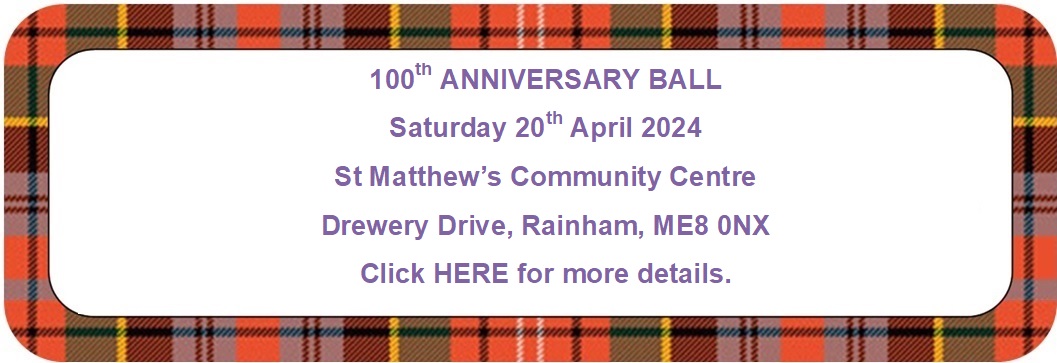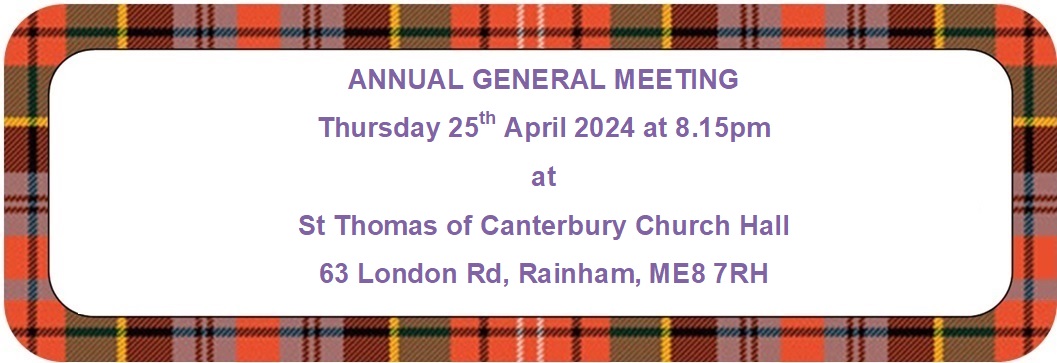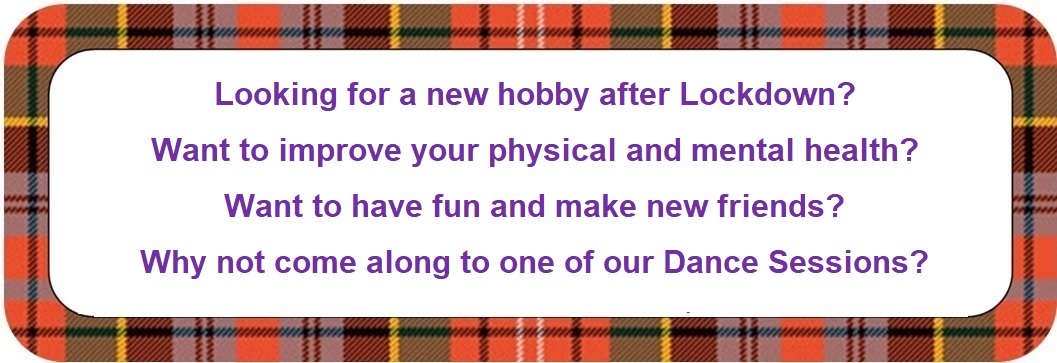* NEXT EVENT *

* COMING UP *

* NEWS and UPDATES *

* COME ALONG *

What is Scottish Country Dancing?
Scottish Country Dancing is a very sociable type of dancing for people of all ages, backgrounds, fitness and experience. It is good fun and a great way to get out, meet people and make friends. It is really good exercise so it keeps you fit and it exercises your mind as well as your body as you have to try and remember what you are supposed to be doing next! There are over 14,000 different dances, so it's difficult to learn them all but the more you dance the more you learn.
With some forms of dancing you could turn up, dance all night and not have to talk to anyone. Not so with Scottish Country Dancing. We usually dance in sets of six or more people so social interaction very much takes place otherwise the whole thing would fall apart. It is all teamwork with hand and eye contact being a necessity. Before long all the set will be chattering about the dance, what they should be doing, what they did, where they went wrong, how to do it better next time, their holidays, the cat at home and the meaning of life. Well perhaps we don’t get that much time between dances!
It's sometimes elegant, often very lively, but always, always, lots of fun.
Why not come along to one of our Dance Sessions or Events and see for yourself?
Just one warning: - Scottish Country Dancing can become addictive!
Frequently Asked Questions
Is it the same as Highland Dancing?
No!
When talking about Scottish dancing images are often conjured up of lone figures performing , very energetic, Sword Dances or the Highland Fling. Whilst some of our members can do this, and to a very high standard, this is actually Highland Dancing and not Scottish Country Dancing.
Highland dancing is usually danced solo whereas Scottish Country Dancing is usually danced in sets of three, four, five or more couples either in round the room, square, triangular or line formation.
There is a certain amount of cross-over, in that there are Scottish Country dances that include highland elements as well as highland-style performance dances which use formations otherwise seen in country dances.
Do I have to be Scottish?
Not at all!
Scottish Country Dancing is open to everyone from age 6 to 126
It is very popular all around the world across Europe, America to Japan and Australia, wherever people can dance. There are now more people doing Scottish Country Dancing outside Scotland than within it, although in Scotland, many people have had the advantage of learning it at school.
There are many clubs in the UK and seventeen just in Kent.
Can I dance all year round?
Yes!
Our Thursday evening Dance Sessions are open all year round, except for Christmas week.
There are plenty of Events, Balls, Dances and Socials to attend throughout the year.
Wherever you are you can be sure to find a warm welcome at a local club and it is possible to dance every day of the week!
As well as UK holidays and short breaks, some of our members travel abroad on dancing holidays where they are tourists during the day and Scottish dancers at night!
Do I have to bring a partner?
No!
You are welcome to come along on your own and you will find plenty of others to dance with you. If you are a little shy about coming on your own then contact us before you come and someone will meet you at the door and introduce you to everyone.
Anyone can ask anyone else to dance. Usually, dancers take a different partner for each dance. This adds to the social nature of the dancing, and means that you get an opportunity to meet and dance with lots of different people.
However, if you do have a partner, spouse, a friend or friends, a family member, or the whole family that want to dance by all means bring them along. It’s a great way to have fun together. Even if they don't wish to dance, they are welcome to sit and enjoy the music and watch the action.
Do I have to be really fit?
No!
Some dances (called Strathspeys) have a slower tempo and can be danced by those who are less physically able. However, Scottish Country Dancing is great physical and mental exercise and the more you dance the fitter you will become.
Do I have to be a Member?
No!
You can come along to our Dance Sessions, Socials and Events without being a Member. However, there are benefits in joining and many people decide to become a Member shortly after testing it out and attending their first few sessions.
Do I have to sign up for lots of sessions?
No!
You can attend Dance Sessions whenever and as little or often as you like.
You can turn up as and when, but as with all things, the more you do it, the quicker you will learn and improve.
How much does it cost?
Our Thursday evenings Dance Sessions cost £3 per session. First session is FREE.
The cost of our Events vary from around £5 up to around £35 depending on the venue, cost of catering and whether or not there is a live band.
Many of our Socials are free.
Do I need to wear a kilt or special clothing?
No!
For our Dance Sessions usually comfortable casual clothes are worn. We would suggest that you come to Dance Sessions dressed with layers of loose clothes so that clothing can be adjusted as the evening warms up but you can wear whatever you feel comfortable in.
For Events, Dances and Balls however dress can be more formal. Men can and do wear kilts but it is not obligatory. Men who are used to wearing a kilt find it comfortable for dancing, but many men dance in trousers for several years before investing in a kilt and some always dance in trousers or trews.
Women can wear trousers or a skirt with a top or blouse or dresses, or a ball gown, depending on the occasion!
Do I need special shoes?
No!
Initially, any flat soft shoes suitable for dancing can be worn, such as shoes with a non-slip sole, jazz or ballet shoes or canvas plimsolls. We do not encourage stilettos or work boots!
However, it helps to have the right footwear and after a few Dance Sessions, you may want to get proper Scottish Country Dancing soft leather pumps or ghillies. These can be purchased from:
Other Local and National suppliers are available!
What kind of music is used?
For our Dance Sessions we use recorded music but often have live bands at our Events and Socials. The tunes are typically played on an accordion, fiddle, keyboard and drums (not usually bagpipes!)
Scottish country dances include reels (including hornpipes), jigs, and strathspeys according to the type of music they are danced to. Reels and jigs have fast tempos, quick movements and a lively feel. Strathspeys have a much slower tempo and a more elegant style.
Click the button below to listen to some samples:
Do I have to be an experienced dancer?
No!
If you have never danced before, with a bit of time and practice you will soon pick it up.
Some aspects of Scottish Country Dancing can be confusing to the new dancer - don’t let that discourage you, a bit of perseverance in learning the basics soon pays off and a whole world of fun and enjoyment awaits you.
There are many Scottish Country Dances with straightforward movements that can be danced easily by a beginner or novice dancer; however, there are also some more complex dances that require a higher degree of proficiency!
So whether it is your first time or you are a seasoned veteran, dancers welcome you to the floor and will gladly help you through the dances.
Remember, it's all about having fun!
Do I have to learn all the dances?
No!
You don't have to learn any dances if you don't want to, although you will enjoy dancing more if you learn at least some.
Most dances at our Dance Sessions are ‘walked through’ or ‘re-capped’ but if you have time to do your homework, Cribsheets for our Thursday Dance Sessions are available in advance on this Website.
Some dances at our Events may be either ‘walked through’ or ‘re-capped’. Cribsheets for our Events are published on this Website well in advance and dances for upcoming Events are usually practiced at the weekly Dance Sessions.
You are always more than welcome to bring your own Cribsheets and carry them on to the dance floor.
NB/ The videos in the above link show how it should be done and not necessarily how it is actually done!! 😃
For a less formal insight check out:
Do I have to learn lots of complicated steps?
No!
You don't have to learn any steps at all if you don't want to, but you should try and learn the main basic steps and more importantly, the basic formations, which are found in most dances.
You should also try to familiarise yourself with some of the terminology used in Scottish Country Dancing, so that when someone yells “up” or ”down” or “cast” or “right and lefts” or “teapots” or “reel” or “right hand star”, you will at least have some idea of what to do, even if you don’t quite go in the right direction!
This terminology, the basic steps and formations can be learned at all of our weekly Dance Sessions.
There is no better way to learn than to just turn up and join in but here is a helpful beginners ‘online guide’ including steps, foot positions and descriptions of terms to get you started.
If you have any other questions feel free to get in touch. We will be pleased to hear from you!
